They Have an Excellent Art to Cast Our Pewter and Brasse Into Very Neate and Artificiall Pipes
Magritte and the subversive power of his pipe
(Image credit:
Succession Magritte c/o SABAM
)
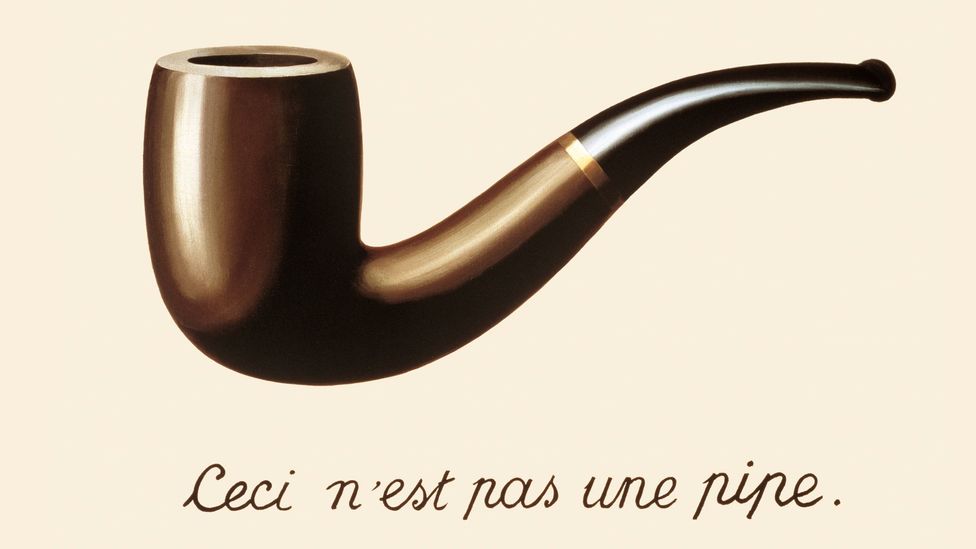
Some think that this mysterious Magritte painting is the beginning of mod art. Information technology inspires a lot more questions than you might think, writes Cath Pound.
R
René Magritte's The Treachery of Images (This is Not a Pipe) is i of the most famous yet persistently enigmatic works in the history of art. One of the word-paradigm series of paintings in which the Belgian artist sought to claiming linguistic and visual conventions, information technology was likewise role of his life-long quest to show that images could exist equal to words in the expression of consciousness.
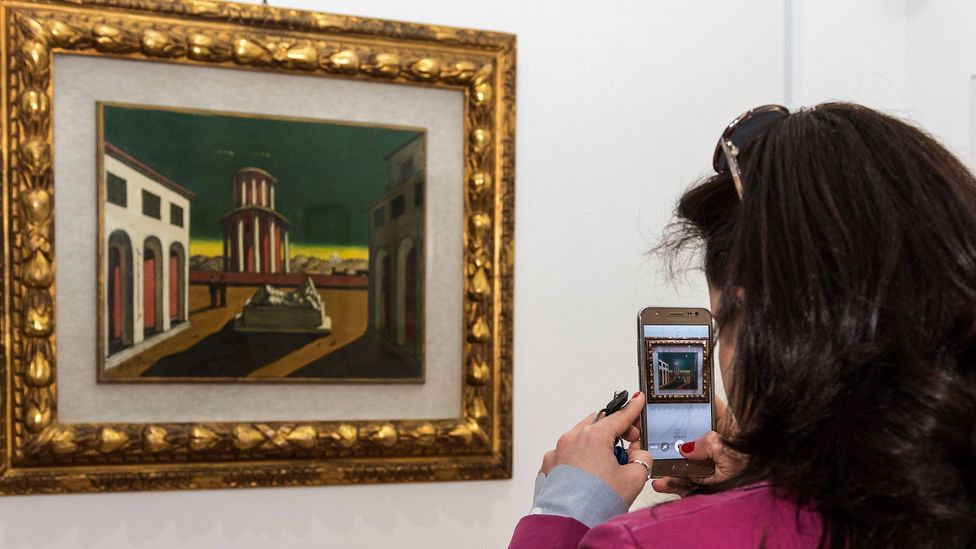
Giorgio de Chirico'south perspective-distorting collage-style paintings were a great influence on Magritte (Credit: Getty Images)
Asking philosophical questions, rather than giving art historical answers, had long been Magritte's aim. Although he had begun painting at the age of 12 and experimented with Cubism and Futurism, Magritte soon tired of painting as an end in itself and disliked being chosen an artist, considering himself a thinker who communicated through paint. Well versed in the history of philosophy, he was enlightened that from Plato to Hegel, figurative representation had been dismissed as a confusion of the senses and poetry considered the highest form of human expression.
Surrealism, the movement to which Magritte would get aligned, had begun life as a largely literary movement, and its founders were equally sceptical about the value of painting. It was merely with the discovery of the metaphysical works of Giorgio De Chirico, through whom Magritte claimed to have discovered "the clout of poetry over painting", that they – and he – changed their minds.
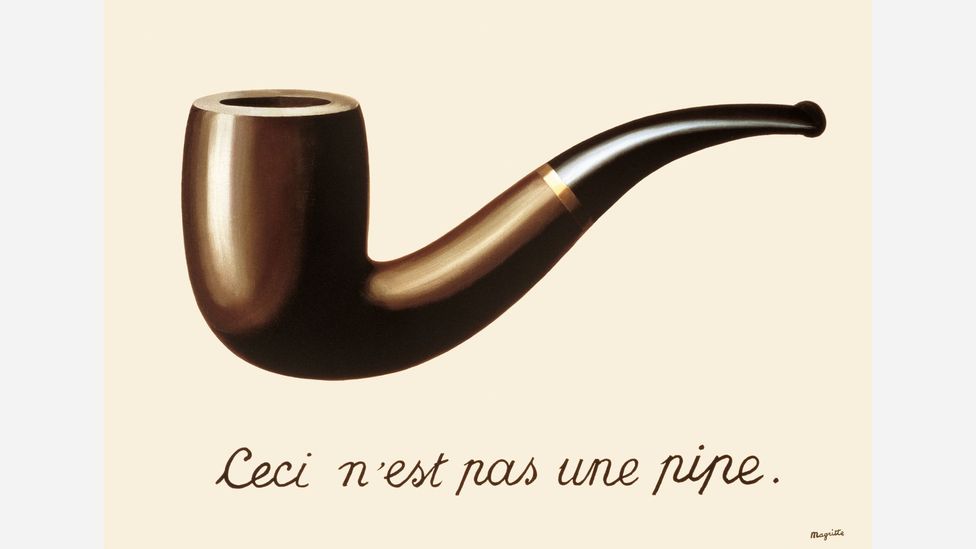
Either the text 'this is non a pipage' is deliberately misleading or it makes u.s.a. aware of the departure between representation and authenticity (Credit: Succession Magritte c/o SABAM)
In his famous essay on The Treachery of Images, the philosopher Michel Foucault refers to the artwork every bit an "unravelled calligram", a calligram being an paradigm formed of the words which describe it, which Magritte had "unravelled" by separating the image from the text.
Although Magritte disagreed with this definition, he certainly believed that an prototype was as capable of expressing thought as poetry. Equally Draguet says, for Magritte poesy was "beyond the word; something deeper than the word".
Real or not existent?
His decision to pigment a pipe to emphasise this point may well take been down to the fact that before long before Magritte began work on The Treachery of Images, André Breton and Paul Éluard, 2 of Surrealism's leading figures, published Notes on Poetry in La Révolution Surréaliste, in which they declared "poetry is a pipe".
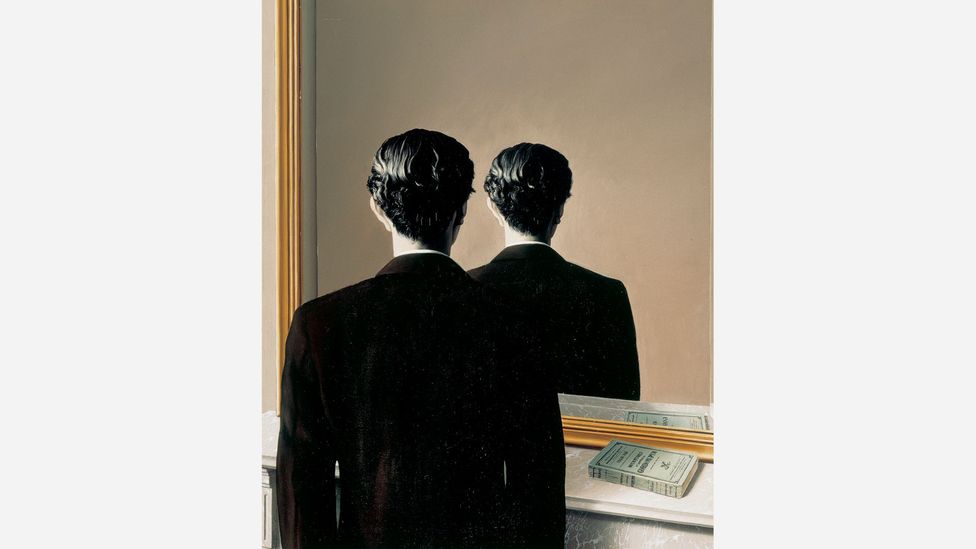
Magritte'southward Not to Be Reproduced suggests all sight is an illusion (Credit: Charly Herscovici c/o SABAM)
Magritte's declaration that "this is not a pipe" could then be seen as a merits that information technology is something different, but equally valid. Although nosotros should also bear in mind that the original title of the painting was L'usage de la parole I (The Use of Voice communication I), which implies that nosotros should question the veracity of the words, not the image.
Magritte'south apparent ambivalence to such a dramatic switch of accent may seem odd but, equally his colleague Paul Nougé appreciated, Magritte'south titles were always a "commodity for discussion", and "not explanations". He understood that an individual'due south response to an epitome would always exist dependent on their personal experiences and understanding of the object.
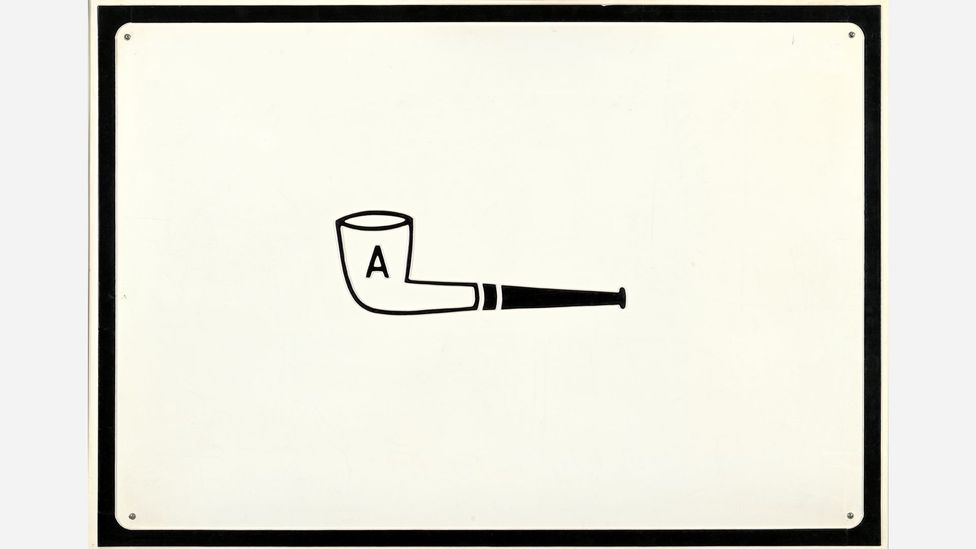
Broodthaers took Magritte's conceptual games a step farther, though he oft still incorporated the image of a pipe (Credit: Getty Images)
The indefinable nature of Magritte's paintings meant that they would become a particularly provocative and fertile source of inspiration for younger artists. "If you take answers, you are obliged to go in the same management," says Draguet. "If you ask questions you tin can take the question and start over again."
Notwithstanding, although Magritte had painted The Treachery of Images for a show in Paris in 1929, the stock market place crash that twelvemonth meant that many galleries closed, and information technology wasn't until a 1954 exhibition at the Sidney Janis Gallery in New York that his piece of work began to concenter attending amongst a new generation of artists including Andy Warhol, Paul Rauschenberg and Jasper Johns.
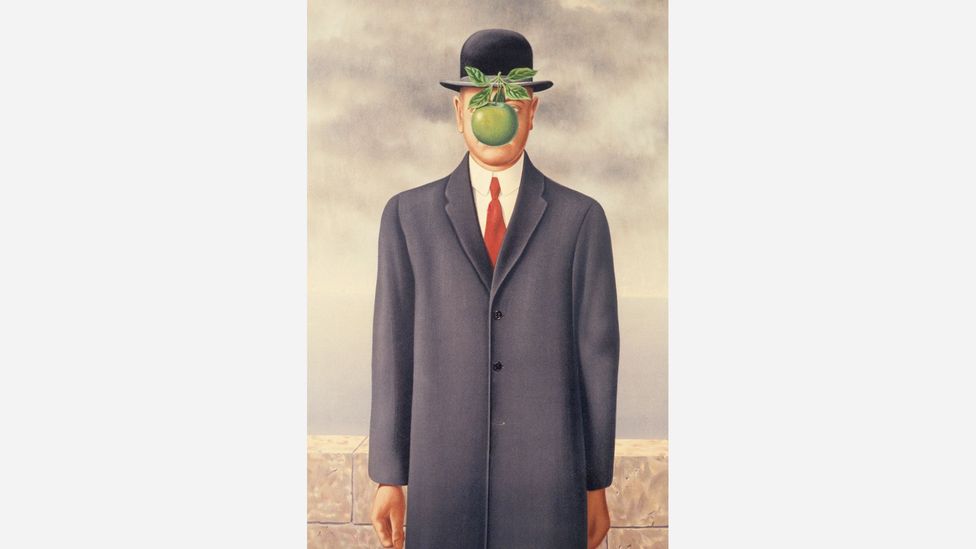
Magritte's The Son of Man, from 1964, is maybe his all-time known work of fine art (Credit: Alamy)
For Johns, known for depicting everyday objects such as numbers, targets and flags in unexpected means, the exhibition "actually made an impression", according to art historian Roberta Bernstein, author of the Catalogue Raisonné of his work. "I call up it was one of the things that was brewing in his mind earlier he painted his commencement flag," she says.
"Conceptually the thought of Magritte proverb 'this is not a pipage, it's an image' is fundamental to understanding Johns' flag," she adds, although Johns twists the question so that information technology becomes, "is this a flag or is it an paradigm?"
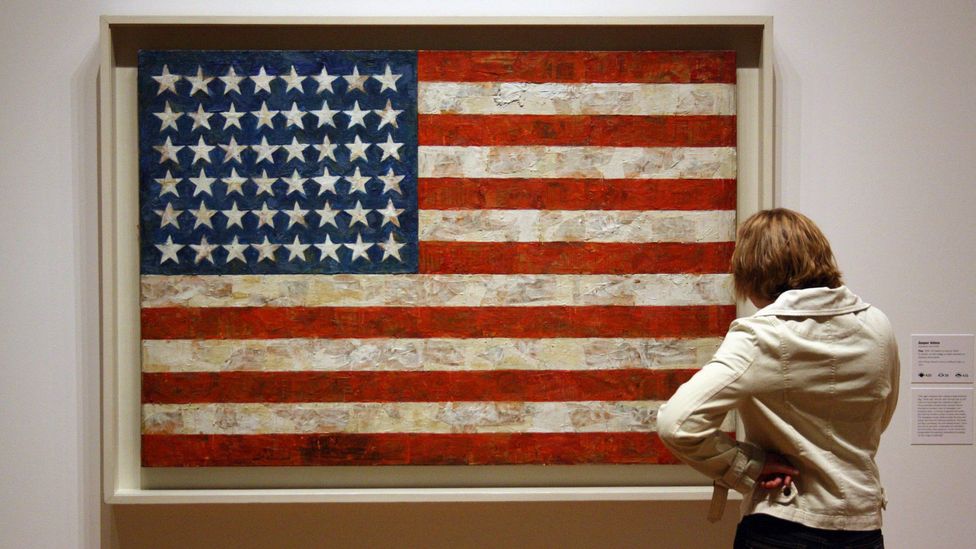
Jasper Johns' Flag posits questions similar to Magritte'southward work – is this a flag even though information technology's made upward of painted bits of newspaper rather than cloth? (Credit: Alamy)
She believes he also had an bear on on Rauschenberg and "the fact that both of them started collecting his work when they could beget it is a reinforcement of that".
Rauschenberg ever denied the link, but seeing his Bellini Series, a collection of Pop Art collages of Renaissance figures, next to Magritte's The Fix-Fabricated Bouquet, in which Boticelli's Primavera is arbitrarily placed on the rear of a man in a bowler hat, it is difficult to believe that there wasn't some influence.
Claes Oldenburg would also draw inspiration from Magritte'southward piece of work. The origins of his abnormally enlarged objects can be traced back to Magritte's Personal Values, in which Magritte places outsized objects in a bedroom whose wall is a painted sky. However, Magritte was reportedly unwilling to encounter himself as a precursor of Pop Art, a movement which he felt sacrificed also much to the vagaries of fashion. According to Draguet, Magritte was generally ambivalent to contemporary developments in art. The notable exception was his fellow Belgian Marcel Broodthaers: his "spiritual son", as Draguet puts it, with whom he shared a close affinity.
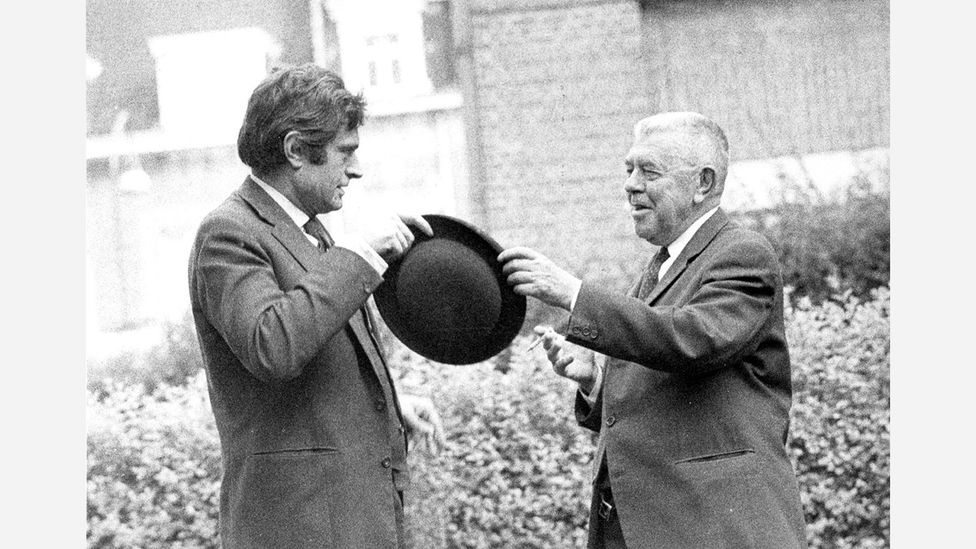
Marcel Broodthaers, left, was amongst the younger generation of artists to exist influenced by Magritte, right (Credit: Estate of Marcel Broodthaers/RMFAB Brussels/J Geleyns/Ro Browse)
The two met after World War 2 and bonded over a mutual appreciation of the poet Mallarmé, whose theories about representation were close to their own. Although Broodthaers had begun life every bit a poet, he turned to the visual arts in 1964, creating his first piece of work by embedding unsold copies of his verse collection, Pense-Bête, in plaster. He took Magritte's play on words to a dissimilar level by encrusting his Music Lectern with mussel shells, exploiting the difference in significant of the French word moule depending on the gender, to question the definition of art and the art market.
Broodthaers found a item source of inspiration in The Treachery of Images, which he considered the starting point for modern art, and pipes feature frequently in his work. Possibly it was Broodthaers' involvement that acquired Magritte to re-imagine the painting on several occasions, creating pipes wafting fume and even one defiantly declaring "this continues to not be a piping". But if we hope to find clarification from these subsequently versions, it shortly becomes articulate that we may too attempt to take the pipe from the canvass and smoke it. It continues to be an enigma.
If you would similar to comment on this story or anything else you have seen on BBC Civilization, head over to our Facebook page or message u.s.a. on Twitter .
And if y'all liked this story, sign up for the weekly bbc.com features newsletter , chosen "If You lot Only Read 6 Things This Week". A handpicked selection of stories from BBC Hereafter, Culture, Capital and Travel, delivered to your inbox every Fri.
Source: https://www.bbc.com/culture/article/20171205-magritte-and-the-subversive-power-of-his-pipe
0 Response to "They Have an Excellent Art to Cast Our Pewter and Brasse Into Very Neate and Artificiall Pipes"
Postar um comentário